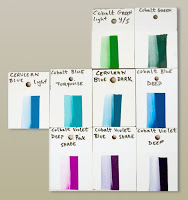Cobalt pigments are classified as synthetic inorganics. Unlike naturally occurring mineral inorganics, cobalt pigments do not naturally occur but must be made by calcining (firing at very high heat). Also, unlike modern organic pigments, cobalt pigments are not carbon-based.

What became apparent over years of making paints is that every cobalt pigment mixed nicely with any other cobalt pigment. Unlike so many combinations, the mixes never became muddy or dull. Of interest to artists is the wide range available of cobalt colors.
Cobalt produces the most diverse range of pigments currently available in artists' paints: its colors range from cobalt violet through several shades of cobalt blue, two shades of cobalt turquoise, several varieties of cobalt green, cobalt yellow and even a grayish cobalt black. Cobalt pigments tend to be semitransparent, moderately saturated, and very permanent.
All reflect a noticeable amount of light from the red spectrum making for warm yellows, violets and blues, but rather dull greens and turquoises; the greenish compounds with chromium become steadily duller and more opaque as the proportion of chromium is increased.
That dullness is not a bad thing. Indeed, it’s quite useful on the palette, not overpowering mixes as the Pthalocyanine colors do.
While the mixtures among the Cobalt family are very useful, what we found is these paints are at their best when used with other colors outside the Cobalt family. Any mixture of Cobalt Turquoise, Cobalt Violet (Red Shade) and Cadmium Orange Light produces unusually vibrant mixes. Chromium Green Deep and Zinc White produce a tint that can be used in some sections of a sky and definitely in depicting water, trees and most landscape elements.
As with Zinc White being the mixing white, the Cobalt family of colors can be the mixing colors. You won’t go wrong with them.

